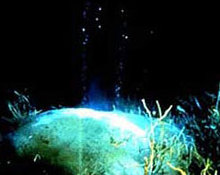-
Seminar Detail

Gas hydrates as planetary-scale water and greenhouse gas
reservoirs: Implications for Astrobiology
Presenter: Megan Elwood Madden
February 20, 2007 02:30 PM Pacific
Gas hydrates (clathrates) are plentiful on Earth, forming ice-like gas reservoirs within seafloor sediments and permafrost. Terrestrial gas hydrates may contain more hydrocarbons (natural gas) than all other conventional petroleum reserves combined. However, terrestrial gas hydrate deposits are not unique within the Solar System. Gas hydrates are likely important reservoirs for water and greenhouse gases on other planetary bodies as well, affecting both the availability of water and the composition of planetary atmospheres. Understanding the thermodynamics and kinetics of hydrate formation and decomposition along with the physical properties gas hydrate materials allows us to predict where hydrates are most likely to form in the Solar System and how these gas hydrates may affect the geochemistry and physical processes on planetary bodies. As sources and sinks for carbon and water, the fate of hydrates in planetary systems is intimately tied to the potential for biological activity.
Participation Instructions
POLYCOM
RSVP to Marco Boldt (Marco.Boldt@nasa.gov) and connect to WebEx as instructed below. If you need Polycom help during the live event, call the videoconferencing help-desk at (650) 604-6412
WebEx
The slides from the seminar can be accessed real-time using WebEx at:
https://nasa.webex.com
Enter the meeting number: 927 144 458 Hit the "join now" button.
Enter your name or site name (this is not an assigned log-in name, please use your institution name or your first and last name), email and the
password: madden123* (case sensitive)
If you've never joined a WebEx meeting before, please allow an extra 5-10 minutes to install the plug-in.
Without a Polycom...
1) You can listen to the seminar on the telephone while viewing the slides in WebEx (see WebEx instructions above). The NASA conference phone number will be displayed when joining the WebEx meeting.
2) You can watch the Realplayer webcast at:
http://vanseg-1.arc.nasa.gov/2007/AB070220-01.ram and view the slides in WebEx (see WebEx instructions above) There is a 30 second delay for the webcast, so you will need to control the slides manually using the arrow buttons in WebEx. Questions for the speaker can be posted in the WebEx chat area to be answered at the end of the talk. Do not try to watch the Realplayer webcast at the same time as the Polycom or the phone. Due to the delay in the webcast, it will sound awful, unless you like dissonance.
December 21, 2007
